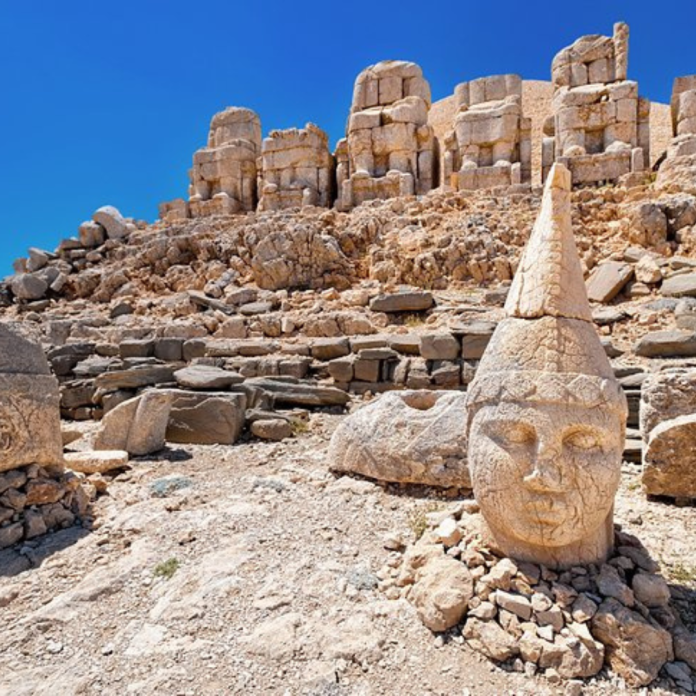High in the remote mountains of southeastern Turkey, atop the desolate peak of Mount Nemrut, lies one of the most enigmatic and majestic monuments of the ancient world—a forgotten shrine to a long-dead king who saw himself as a god. Here, ten colossal stone statues—weathered but defiant—sit in solemn silence around a massive man-made mound, guarding what may still be the untouched tomb of King Antiochus I of Commagene.
Often called the “eighth wonder of the ancient world,” this sacred sanctuary rises more than 7,000 feet above sea level. It was built during the 1st century B.C. as the crowning glory of a small but ambitious kingdom that thrived at the crossroads of East and West. With artistic grandeur and spiritual reverence, it reveals a stunning fusion of Greek and Persian traditions—gods, symbols, and kings blended into a singular, theocratic vision.

A Kingdom Carved from Two Worlds
The story begins in the ancient province of Commagene, a land shaped by conquest and rebellion. Once a corner of the crumbling Seleucid Empire, Commagene broke free around 163 B.C. when the satrap Ptolemaeus declared himself king. A dynasty was born, and within a century, under the rule of Antiochus I (circa 70–36 B.C.), the kingdom entered a golden age.
Antiochus presided over a fragile buffer state caught between the expanding Roman Republic and the mighty Parthian Empire. He chose neutrality—and divinity. Declaring himself both ruler and god, Antiochus merged the cultural legacies of Alexander the Great and the Achaemenid kings of Persia. His monument on Nemrut was meant not just to house his body, but to immortalize his soul among the gods.
Nemrut: A Temple Above the Clouds
The scale of the construction was staggering. Antiochus had the summit terraced and a 164-foot-high tumulus built—an artificial mountain of crushed stone nearly 500 feet in diameter. At its base he placed enormous statues, each between 10 and 30 feet tall, arranged on massive terraces that aligned with the stars. Five central figures dominate the site: the king himself sits among deities who combine the traits of Greek and Persian gods.
- Zeus-Oromasdes blends the thunderbolt of Olympus with the fire of Zoroastrian divinity.
- Apollo-Mithras-Helios-Hermes is both sun god and messenger.
- Artagnes-Heracles-Ares unites the Persian protector of kings with the Greek god of war.
On either side, lions and eagles—symbols of earthly and celestial dominion—stand watch. These hybrid gods are flanked by altars and stelae showing the king shaking hands with his divine counterparts, an act known as dexiosis.
A Lost Tomb Hidden in Stone
It is believed that the king’s body lies buried beneath the stone mound, within a funerary chamber that has never been discovered. The mound’s construction—millions of tightly packed stones—has made excavation nearly impossible. Attempts to probe the interior, including a major 1950s campaign led by American archaeologist Theresa Goell and German epigrapher Friedrich Karl Dörner, have failed to locate the chamber.
The tomb remains undisturbed—a time capsule sealed for over 2,000 years.
Sacred Rituals on the Mountain of the Gods
This was no ordinary mausoleum. Antiochus’s own inscription—more than 200 lines engraved on the backs of the colossi—reveals that Mount Nemrut was designed as a “hierothesion,” a holy place for both worship and burial. It details the ceremonies once performed here: a Persian-robed priest would crown the statues, burn incense, and lead animal sacrifices. Then, feasting, music, and wine followed—rituals meant to honor both the divine and the dead.
Three processional paths led pilgrims from all directions to the sanctuary, linking Antiochus’s spiritual legacy with the physical world.
Echoes of Forgotten Kings
While other royal tombs of Commagene—like those at Karakuş and Arsameia—were built with tunnels and chambers cut into rock, none match the grandeur of Nemrut. Antiochus’s vision echoed Anatolian tombs of earlier kings, like Midas in Gordium and Alyattes in Sardis, but far surpassed them in scale, artistry, and altitude.
In death, he sought to rule forever—not just over a kingdom, but over heaven and earth.
Rediscovery and Resilience
Mount Nemrut was long forgotten by the outside world, its isolation and harsh terrain shielding it from ancient chroniclers. It wasn’t until 1881, when German engineer Karl Sester stumbled upon the site, that its splendor reemerged. Later scholars and excavators, including Osman Hamdi Bey, Otto Puchstein, and Carl Humann, confirmed its significance.
Despite earthquakes, erosion, and vandalism, much of the sanctuary still stands, awe-inspiring and mysterious. In 1987, UNESCO recognized Mount Nemrut as a World Heritage Site, securing its place in the modern imagination.
The Tomb Still Waits
Over two millennia later, the tomb of Antiochus I remains sealed, untouched, and possibly intact. Deep beneath the crushed stone lies one of the last great undiscovered chambers of the ancient world—perhaps still holding treasures, inscriptions, and secrets of a man who ruled as both king and god.
And so Mount Nemrut endures, where gods sit in silence, lions face the rising sun, and a forgotten monarch may still slumber beneath the stones.



